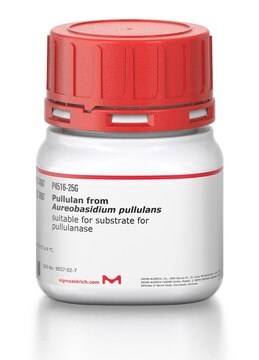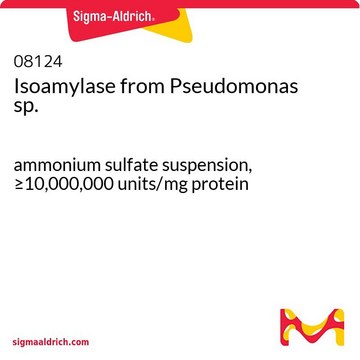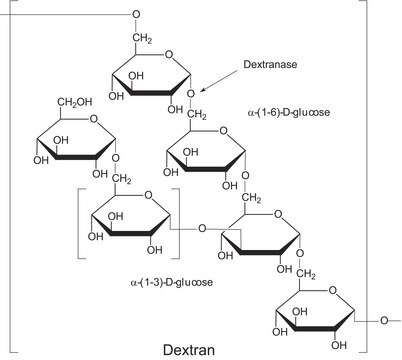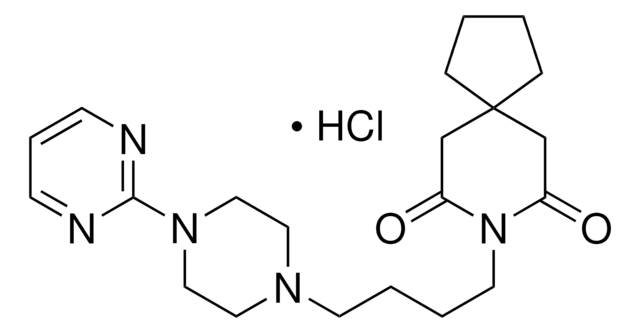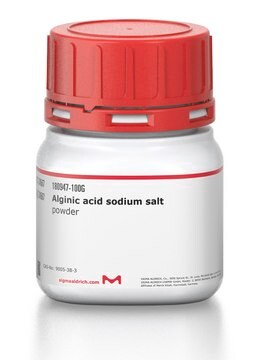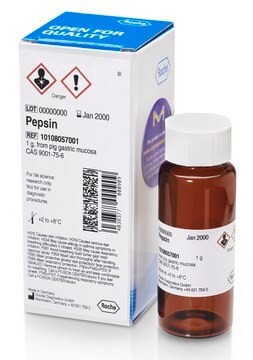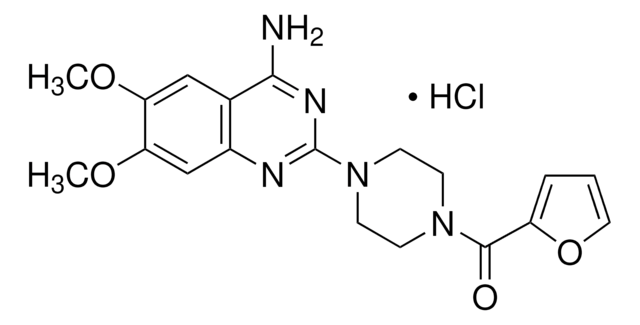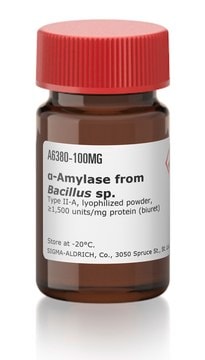E2412
Pullulanase microbial
Synonyme(s) :
Pullulanase microbial, Promozyme® D2
Se connecterpour consulter vos tarifs contractuels et ceux de votre entreprise/organisme
About This Item
Numéro CAS:
Numéro MDL:
Code UNSPSC :
12352204
Nomenclature NACRES :
NA.54
Produits recommandés
Produit recombinant
expressed in Bacillus subtilis
Niveau de qualité
Forme
aqueous solution
Activité spécifique
≥1000 NPUN/g
Température de stockage
2-8°C
Application
Pullulanase is a glucanase that degrades pullulan. It is commonly used for starch-debranching as well as to study polysaccharide utilization.
Actions biochimiques/physiologiques
Type I pullulanases specifically hydrolyse α-1,6 linkages, while type II pullulanases are also able to hydrolyse α-1,4 linkages.
Autres remarques
View more information on enzymes for complex carbohydrate analysis at www.sigma-aldrich.com/enzymeexplorer
Informations légales
A product of Novozymes Corp.
Novozym is a registered trademark of Novozymes A/S
Promozyme is a trademark of Novozymes Corp.
Code de la classe de stockage
12 - Non Combustible Liquids
Classe de danger pour l'eau (WGK)
WGK 1
Point d'éclair (°F)
Not applicable
Point d'éclair (°C)
Not applicable
Certificats d'analyse (COA)
Recherchez un Certificats d'analyse (COA) en saisissant le numéro de lot du produit. Les numéros de lot figurent sur l'étiquette du produit après les mots "Lot" ou "Batch".
Déjà en possession de ce produit ?
Retrouvez la documentation relative aux produits que vous avez récemment achetés dans la Bibliothèque de documents.
Les clients ont également consulté
K A Smith et al.
Journal of bacteriology, 171(4), 2116-2123 (1989-04-01)
We have cloned a pullulanase gene from Bacteroides thetaiotaomicron. The pullulanase expressed from this clone in Escherichia coli was cell associated and soluble and had a molecular mass of 72 kilodaltons by gel filtration. Maxicell analysis of proteins coded by
Nasima Chorfa et al.
Polymers, 14(10) (2022-05-29)
In this work, a valorization of the starch stemming from downgraded potatoes was approached through the preparation of starch nanoparticles using different physical methods, namely liquid and supercritical carbon dioxide, high energy ball milling (HEBM), and ultrasonication on the one
Christopher C Ibenegbu et al.
Microbial cell factories, 21(1), 251-251 (2022-11-30)
The starch in waste bread (WB) from industrial sandwich production was directly converted to ethanol by an amylolytic, ethanologenic thermophile (Parageobacillus thermoglucosidasius strain TM333) under 5 different simultaneous saccharification and fermentation (SSF) regimes. Crude α-amylase from TM333 was used alone
Kornelia T Kaczmarska et al.
Journal of agricultural and food chemistry, 65(46), 10064-10073 (2017-10-24)
This study investigated the effect of germination and fermentation on the composition of carbohydrates in Australian sweet lupin. Specifically, the amount of sugars (sucrose, fructose, and glucose), starch, oligosaccharides (verbascose, stachyose, and raffinose), and dietary fiber were measured in germinated
Youran Li et al.
Journal of agricultural and food chemistry, 60(44), 11164-11172 (2012-10-18)
The pulA1 gene, encoding a novel thermostable type I pullulanase PulA1 from Bacillus sp. CICIM 263, was identified from genomic DNA. The open reading frame of the pulA1 gene was 2655 base pairs long and encoded a polypeptide (PulA1) of
Notre équipe de scientifiques dispose d'une expérience dans tous les secteurs de la recherche, notamment en sciences de la vie, science des matériaux, synthèse chimique, chromatographie, analyse et dans de nombreux autres domaines..
Contacter notre Service technique